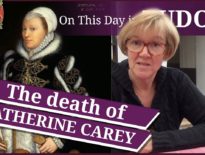On this day in Tudor history, 16th January 1572, Thomas Howard, 4th Duke of Norfolk, eldest son of the late Henry Howard, Earl of Surrey, was tried and found guilty of treason at Westminster Hall.
Norfolk had promised Queen Elizabeth I that he would not get involved with Mary, Queen of Scots, ever again, but it was a promise that he just couldn't keep. Once again, he had become involved in a plot against Elizabeth I and in support of Mary, Queen of Scots. He wouldn't escape punishment this time.
Find out exactly what happened in today's talk.
Here's my video on Norfolk's execution
Also on this day in Tudor history, 16th January 1549, Edward VI's uncle, Thomas Seymour, was alleged to have broken into the King Edward VI’s apartments at Hampton Court Palace to kidnap the young King. You can find out exactly what happened in my video from last year:
Also on this day in history:
- 1486 – The Bishop of Imola, the papal legate, authorised the marriage of Henry VII and Elizabeth of York, which was due to take place on 18th January.
- 1501 – Birth of Sir Anthony Denny, courtier and close friend of Henry VIII, at Cheshunt. He was the second son of Sir Edmund Denny and his wife, Mary.
- 1558 – Death of Thomas Alsop, Chief Apothecary to Henry VIII and Serjeant of the Royal 'Confectionary' to Edward VI. He was buried in St Mary Woolchurch.
- 1585 – Death of Edward Fiennes Clinton, 1st Earl of Lincoln, military commander, in London. He was buried in St George's Chapel, Windsor Castle. Clinton served Elizabeth I as a privy councillor and Lord Admiral until his death.
- 1606 – Death of Matthew Hutton, Archbishop of York, at Bishopthorpe. He was buried at York Minster.
Transcript:
On this day in Tudor history, 16th January 1572, Thomas Howard, 4th Duke of Norfolk, eldest son of the late Henry Howard, Earl of Surrey, was tried and found guilty of treason at Westminster Hall.
Norfolk had been arrested and imprisoned in the Tower of London in October 1569 and questioned regarding plans for him to marry Mary, Queen of Scots. Norfolk denied involvement in the 1569 Rising of the North, which sought to depose the queen and to replace her with Mary. He was, however, secretly corresponding with Mary in cipher and sent her gifts at Christmas and during the summer of 1570.
In June 1570, Norfolk begged Elizabeth’s forgiveness and vowed “never to deale in that Cause of Mariage of the Quene of Scottes, nor in any other Cause belonginge to her, but as your Majestie shall commaund me”. In August 1570, he was released into house arrest at Howard House, formerly London Charterhouse, in London.
It wasn’t long before he was in trouble again, having broken his promise to Elizabeth. When the Ridolfi Plot, a plot to free Mary and put her on the throne of England, came to light in 1571, it was found that Norfolk, who had initially refused to support the plot, had met with Roberto Ridolfi, a Florentine banker and papal agent, given his approval of the plot, and signed letters to the pope, Philip of Spain, and the Duke of Alva, Philip’s commander in the Netherlands who was going to launch an invasion of England. Under interrogation, Norfolk’s servants confessed to their involvement and implicated the duke, who was apprehended and taken to the Tower in September 1571.
In December 1571, the Grand Jury of Middlesex, headed by Norfolk’s friend, Thomas Gresham as foreman, drew up an indictment against him. Norfolk was charged with “having conspired and imagined to deprive the queen of her crown and dignity, and compassed to excite sedition, to cause great slaughter amongst the queen's lieges, to levy war and rebellion against the queen, to subvert the government, to change and alter the pure religion established in the kingdom, and to bring in strangers and aliens to invade the realm, and to carry on a bitter war against the queen.” The acts of treason were:
1. Seeking to marry the pretender, the Queen of Scots, and sending to and receiving from her tokens, and sending money to her.
2. Corresponding with the Earls of Northumberland and Westmorland, and others, who were described as traitors and fugitives from justice.
3. Aiding, adhering to and comforting several named Scottish lords, who were described as “enemies of England”
4. and corresponding with the pope, Philip of Spain and the Duke of Alva “in order that the king of Spain might invade England and deprive the queen of her royal dignity”.
On this day in 1572, Norfolk was tried at Westminster Hall by a jury of 26 of his peers, with George Talbot, Earl of Shrewsbury, acting as High Steward. Norfolk maintained his innocence but his own admissions and the written confessions of others involved were used against him. The jury was unanimous in finding him guilty of high treason. He was sentenced to death and on 26th January 1572, he was degraded from the Order of the Garter.
Queen Elizabeth I, however, was reluctant to sign Norfolk’s death warrant – he was, after all, the highest peer of the land - and over the next few months, Norfolk took the opportunity to plead his loyalty to the queen by letter. In May 1572, Parliament put pressure on the queen to act against Mary, Queen of Scots, and Elizabeth finally signed Norfolk’s death warrant. He was beheaded on Tower Hill on 2nd June 1572 and his remains buried in the Chapel of St Peter ad Vincula at the Tower of London.



Leave a Reply